There's a black hole right in our cosmic backyard.
Astronomers from the European Space Agency (ESA) recently announced that they found an average-sized black hole about 6,000 light-years away from the Earth, which could help experts know about them and the universe.
Experts believe average-sized black holes travel in the universe, but they have found only a few so far.
ESA Black Hole Discovery Details

The ESA mentioned in a report that its astronomers found a minuscule region in the globular star cluster Messier 4 with the mass of 800 suns creating chaos among nearby stars - a sign pointing toward an intermediate-mass black hole 6,000 light-years away from Earth.
According to Eduardo Vitral, an astrophysicist at the Space Telescope Science Institute in Maryland and the lead author of a study about the discovery, the region is too tiny for them to explain the reason why it is jam-packed with so much mass, and other than there is a single black hole within it. However, he postulates that there might be a "stellar mechanism" experts have yet to know about outside the current laws of physics.
He explained that he and a team of astronomers discovered the region using the latest data from the Hubble Space Telescope and ESA's Gaia spacecraft. Through these, Vitral and his team discovered that the region was about three times smaller than the densest dark mass astronomers had found before in other globular clusters.
Additionally, they noticed that the closer a star was to the central mass, the more randomly it moved, and that the greater the central mass of a star, the faster its stellar velocity was.
These findings led Vitral to believe that an intermediate-sized black hole is within the region in question, adding to the growing evidence that the universe plays host to a rare class of intermediate-sized black holes, helping experts understand them in the process.
Gaia mission scientist Timo Prusti said in a statement that Vitral's discovery could be a step towards being sure that intermediate-mass black holes exist. "Science is rarely about discovering something new in a single moment," Prusti said. "It's about becoming more certain of a conclusion step by step..."
Space.com said that these black holes are elusive to spot and even tougher to confirm due to a lack of explanation for their formation and difficulties in weighing them accurately.
Hubble's Contribution

Vitral said that the discovery of the intermediate-sized black hole in Messier 4 would be impossible without Hubble's unique capabilities, which helped experts zero in on the globular star cluster's core.
According to NASA's Hubble Site, the aging space telescope was equipped with ultraviolet instruments that detect the particle winds coming off accretion disks from stellar-mass black holes. Vitral's team may have used the same instruments others used in discovering supermassive black holes at the center of galaxies to discover the intermediate-mass black holes in Messier 4.









